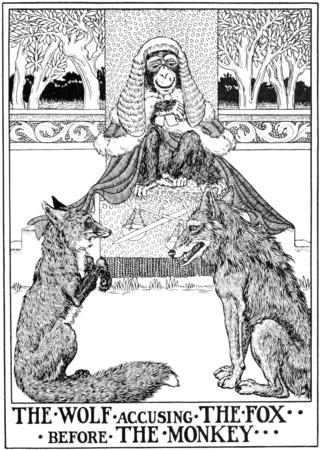
Reynard the Fox is a literary cycle of medieval allegorical Dutch, English, French and German fables. The first extant versions of the cycle date from the second half of the 12th century. The genre was popular throughout the Late Middle Ages, as well as in chapbook form throughout the Early Modern period.

"The Nun's Priest's Tale" is one of The Canterbury Tales by the Middle English poet Geoffrey Chaucer. Composed in the 1390s, it is a beast fable and mock epic based on an incident in the Reynard cycle. The story of Chanticleer and the Fox became further popularised in Britain through this means.

Robin Hood is a 1973 American animated musical adventure comedy film produced by Walt Disney Productions and released by Buena Vista Distribution. Produced and directed by Wolfgang Reitherman, it is based on the English folktale "Robin Hood". Taking place in a world populated by anthropomorphic animals, the story follows the adventures of Robin Hood, Little John, and the inhabitants of Nottingham as they fight against the excessive taxation of Prince John, and Robin Hood wins the hand of Maid Marian. The film features the voices of Brian Bedford, Phil Harris, Peter Ustinov, Pat Buttram, Monica Evans, Terry-Thomas, Roger Miller, and Carole Shelley.
Reynardine is a traditional English ballad. In the versions most commonly sung and recorded today, Reynardine is a werefox who attracts beautiful women so that he can take them away to his castle. What fate meets them there is usually left ambiguous.
Reynard the Fox is a literary cycle of allegorical French, Dutch, English and German fables concerned with Reynard, an anthropomorphic red fox and trickster figure.
Rutebeuf was a French trouvère.

Ysengrimus is a Latin fabliau and mock epic, containing a series of anthropomorphic fables thought to have been written in 1148 or 1149 CE by the poet Nivardus. Its chief character is Isengrim, the Wolf. The plot describes how the trickster figure Reynard, the Fox, overcomes Isengrim's various schemes.

The Waasland or Land van Waas is a historic region in northern Belgium. It is part of the Belgian provinces of East Flanders and Antwerp. The other borders are with the Scheldt and Durme rivers and, to the north, the border with the Dutch region of Zeelandic Flanders. The (informal) capital and major city of the region is Sint-Niklaas.

The fox appears in the folklore of many cultures, but especially European and East Asian, as a figure of cunning, trickery, or as a familiar animal possessed of magic powers, and sometimes associated with transformation. Literature, film, television, games, music, and other forms of cultural expression may reflect the folklore image and reputation.

Sweeney's Men is an album by Sweeney's Men, recorded in early 1968 after 'Galway Joe' Dolan had left the band and been replaced by Terry Woods.
French folklore encompasses the fables, folklore, fairy tales and legends of the French people.
Chanticleer and the Fox is a fable that dates from the Middle Ages. Though it can be compared to Aesop's fable of The Fox and the Crow, it is of more recent origin. The story became well known in Europe because of its connection with several popular literary works and was eventually recorded in collections of Aesop's Fables from the time of Heinrich Steinhowel and William Caxton onwards. It is numbered 562 in the Perry Index.

The Morall Fabillis of Esope the Phrygian is a work of Northern Renaissance literature composed in Middle Scots by the fifteenth century Scottish makar, Robert Henryson. It is a cycle of thirteen connected narrative poems based on fables from the European tradition. The drama of the cycle exploits a set of complex moral dilemmas through the figure of animals representing a full range of human psychology. As the work progresses, the stories and situations become increasingly dark.

An animal tale or beast fable generally consists of a short story or poem in which animals talk. They may exhibit other anthropomorphic qualities as well, such as living in a human-like society. It is a traditional form of allegorical writing.

"The Taill of Schir Chanticleir and the Foxe" is Fabill 3 of Robert Henryson's cycle of thirteen Morall Fabillis composed in Scotland in the later fifteenth century. It is the first of the fable in the poem to be based on Reynardian and beast epic sources rather than on any strictly Aesopian original, although the closest match from Aesop might be The Dog, the Cock and the Fox.
"A Single Blade of Grass" is the fifth episode of the second season of the American crime-thriller television series Millennium. It premiered on the Fox network on October 24, 1997. The episode was written by Kay Reindl and Erin Maher, and directed by Rodman Flender. "A Single Blade of Grass" featured guest appearances by Floyd Red Crow Westerman and Michael Greyeyes.

Van den vos Reinaerde is the Middle Dutch version of the story of Reynard, as written by Willem die Madoc maecte. The poem dates from around 1250. It is considered a major work of Middle Dutch literature and has been called "the pinnacle of Gothic literature in the Netherlands."
The Ecbasis captivi is an anonymous Latin beast fable that probably dates to the middle of the 11th century, and was likely written in the Vosges region of France. It is the oldest example of a European beast fable to survive, and the first medieval European example of anthropomorphic animals. The poem is written in hexameters with Leonine internal rhyme frequently used throughout the poem. The text survives in two manuscripts, both of which now are at the Royal Library of Belgium.











